
Marine conservation going beyond biology and expanding into art.
A personal essay by John Dahlsen.
I am a contemporary environmental artist, author and university art educator whose work examines the passage of time in the landscape and the place of humankind within it. I work with found objects, primarily plastic ocean litter, to create semi-abstract compositions. My work is multi disciplinary and includes, assemblage, sculpture, installation, painting and printmaking.
In my first assemblage works titled “Contemporary Landscapes” made from beach found plastics behind Perspex, created over twenty years ago dating back to 1998 and 1999, I used recycled materials to convey the history and memory of a place, to comment on the human experience of place, beauty and degradation of the environment. There was also a close attention to the sense of aesthetics in these works, as there is now in my current practice.
As a more evolved artist having worked in the environmental art field for over twenty years now, these elements have deepened and become if anything, more sophisticated through both my studio based work and my own research as a practicing visual artist over this time.
I am based in Byron Bay Australia where I have lived for close to thirty years. I was originally born in Sydney Australia and spent my childhood growing up in East Gippsland in Victoria Australia.
After moving to Byron Bay in the early nineties. I moved into a beautiful home that had lime-washed ceilings and walls. This fascinated me because it reminded me of the driftwood that I used to collect and work with when I was in art school at the Victorian College of the Arts in Melbourne. I thought at the time, ‘I want to go back and collect driftwood from those remote beaches of Southern New South Wales and Eastern Victoria’.
Eventually I went back for a few weeks, and that’s when I noticed these plastics washing up. These weren’t there fifteen years prior to that time when I first began collecting driftwood. I became really fascinated by these plastics. Suddenly, I felt that I had this enormous meaning that I could express in my art, a social conscience, an environmental aspect, and still with a commitment to create objects of beauty. I put my brushes down and didn’t paint again for close to fifteen years. Living in Byron Bay made access to beaches easy and was the perfect location to engage in this activist focussed work as an artist.
As part of my work process includes the raw plastic material, my work as a result, is largely created from these items, as a result, the environmental message is largely conditioned by the fact that the raw material I use is ocean litter plastic found on Australian beaches. Further to this, I even have favourite spots in Byron Bay where I collect, including the main beach in Byron, Belongil and nearby Brays Beach near Broken Head and up in the corner of Seven Mile Beach towards Lennox Head. I’ll walk up and down these beaches, collecting plastics in the morning or afternoon.
What I’m finding is that now a lot of people pick up plastics everywhere. They take a bag with them and it becomes a daily chore. It’s become a common thing, which of course I think is great. In the early days when I was doing this activity twenty years ago or so, there wasn’t so much community collecting activity like that. I was collecting huge pieces of plastic that I found. Now, I’m largely collecting really small pieces of plastic known as micro plastics. The current works that I’m working on is a series called the “Pacific Garbage Patch” series, using these really small pieces of plastic to create the image of the Garbage Patch.
The Garbage Patch series is based on the 2018 to 2019 mapping of the Garbage Patch that exists in the centre of the Pacific Ocean. People have asked me, ‘Is this the map of Australia?’ I remind them it’s actually not; it’s the current map of the Pacific Ocean Garbage Patch. Next year it will be different. It’s going to keep changing and it will probably get bigger. It used to be tiny. Five years ago, it was the size of Texas. Now it’s more than double that and my work will continue to develop and reflect these changes.
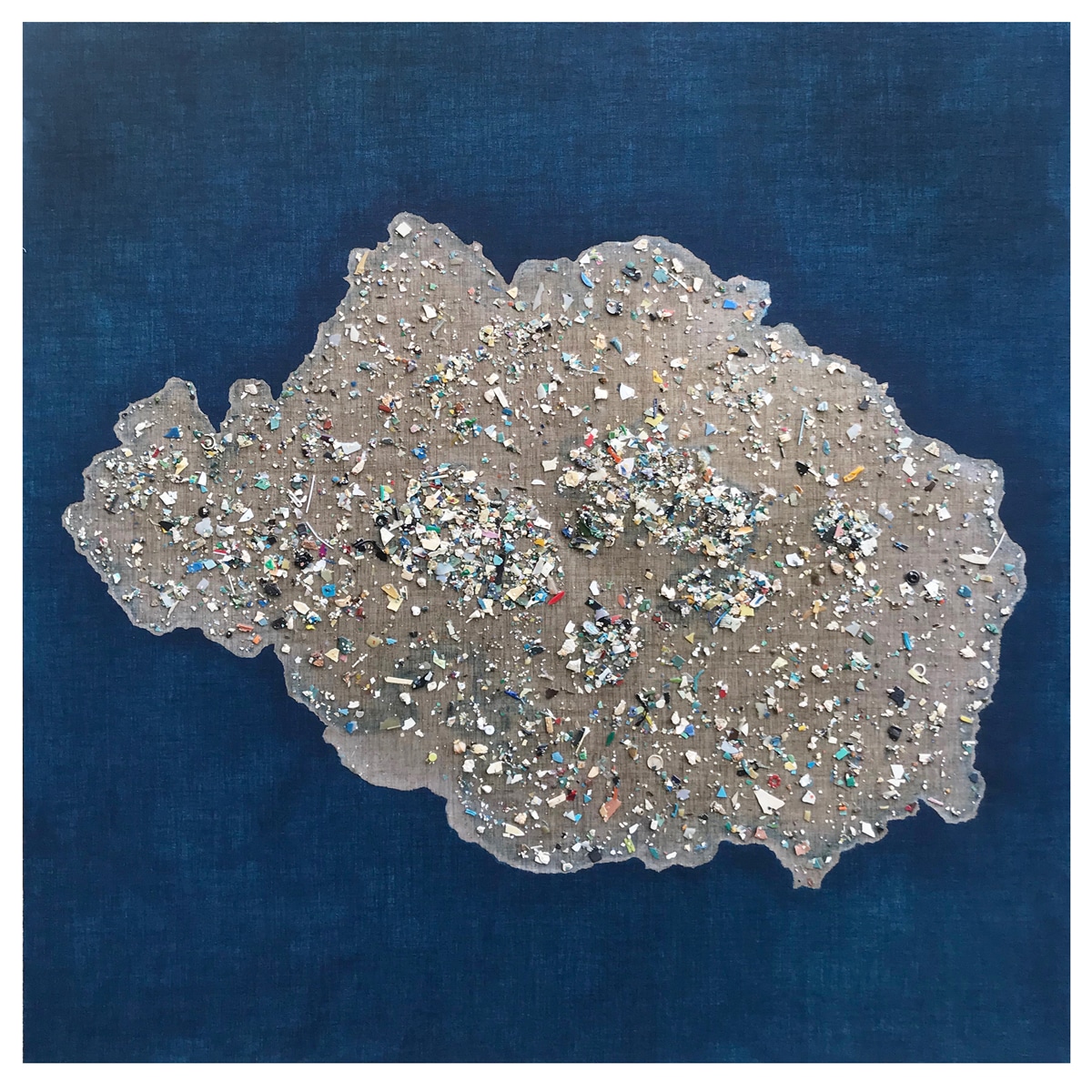
Dahlsen J. (2018) Pacific Garbage Patch #3
My process is to mix the micro plastics with ecologically sustainable plant based resin. It’s a clear resin and I’m actually painting those plastics onto stretched Belgian linen, into the shape of the Garbage Patch in the Pacific Ocean, or as abstract details of the Great Pacific Garbage Patch, or detail of beaches when I see these plastics on the beaches. It’s a meeting of my painting that I did for so many years and my assemblage work. I love the aesthetics of it, I love the fact that it’s so contemporary in the sense that when I walk on the beaches, that’s all I see on it these days – the small pieces of plastic, because everybody else picks up the bigger pieces, but not many are noticing or picking up the smaller pieces, and this is where my microscope abilities are apparent it seems. It’s really interesting for me that I’m still doing this after twenty five years, because back in the early days when I first started collecting beach plastics, I was collecting really large pieces of plastic because not many people then were really collecting it – very few people were collecting it off the beaches. It was just a phenomenon that took humanity by storm especially during the last ten years or so.
Although these plastics are generally seen as ugly or as trash when seen littering the shores of the worlds beaches, I see something different. I see the potential for art. I am aware there is a universal consciousness of these issues about our beaches being polluted by plastics but at the same time, I’m just hoping that with enough of my promotion of this attitude of seeing the potential for beauty in these plastics being transformed into artworks – where people are not being hammered with negativity about the state of the environment – that they become inspired. By simply being exposed to some art that reveals there’s a possibility of renewal.
There’s always that possibility of turning something into the positive. Just like collecting rubbish on beaches, you can do something positive, and it can be beautiful as well. If that message gets across by my making the artwork I do, it can only be a good thing. In truth I see something unique in all the plastics that I collect and include in my art, thus on some level I don’t necessarily dislike these plastics.
I had a self-held commitment as an artist to express contemporary social and environmental concerns then as I do now. This has grown naturally for me as an artist in my development of working with this found object visual language and is supplemented in parallel, with myself as a person having a natural response to world wide ever growing concerns about all aspects of the environment, which now includes the ever pressing need to address global warming and its impact on the environment.
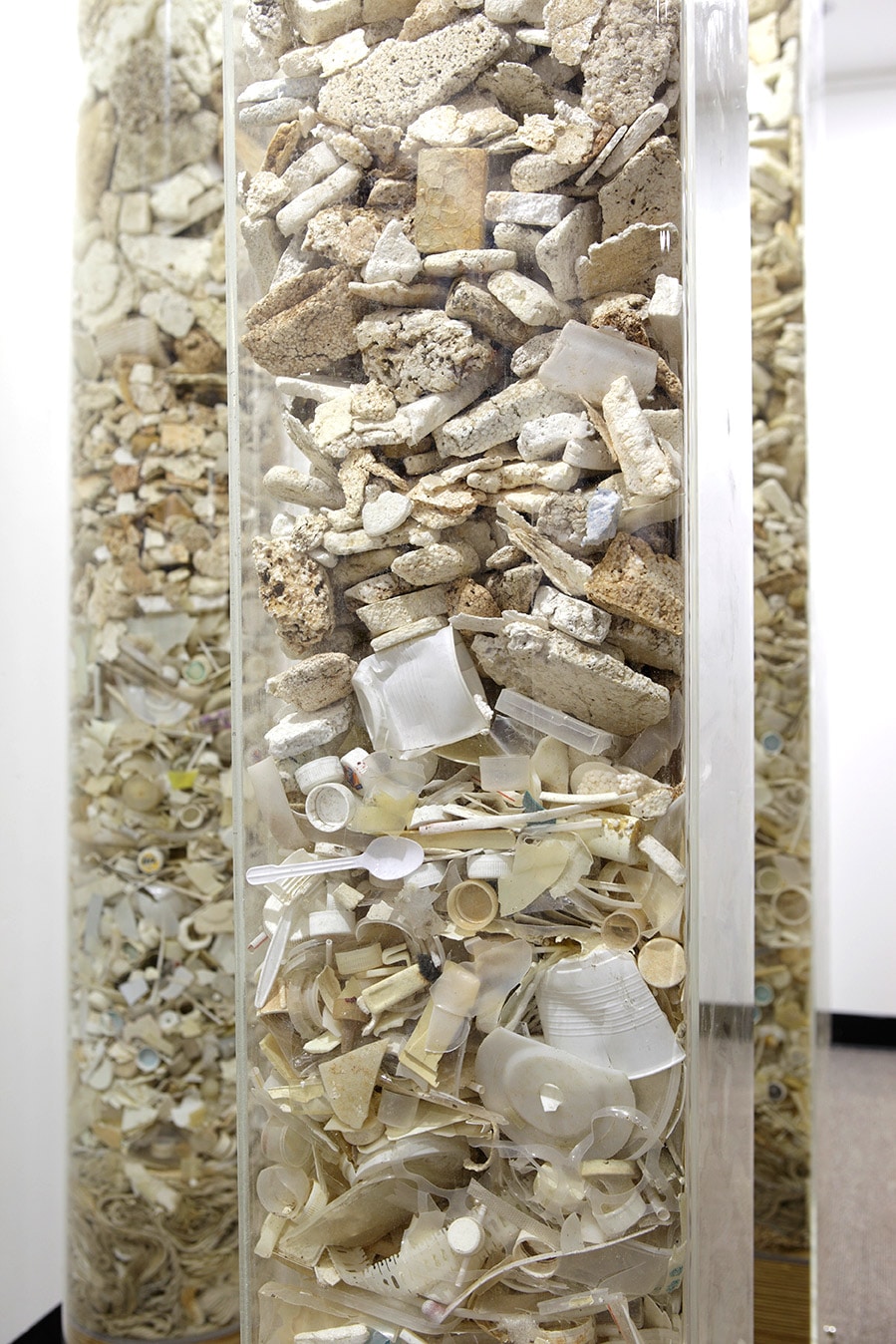
Dahlsen J. (2014) Echoes (Detail)
Initially my foray into making environmentally based art was entirely accidental, I was collecting driftwood from very remote beaches in East Gippsland in Australia, to make furniture for our new home in Byron Bay and I stumbled across huge amounts of plastic debris that had washed up on the beach and felt compelled to collect it, intending to take it to the local dump for recycling. The more plastic I collected the more intrigued I became by this stuff and shipped sixty to eighty jumbo garbage bags of it back to Byron Bay and left it on the side of the studio while I made the driftwood furniture. Then I poured it all out onto the floor, the colours, the forms amazed me. I was on fire, just with the possibilities of what I had discovered.
It was both an ethical and an aesthetic decision to expand it it as an artform. However I believe it was initially aesthetic considerations and ethical considerations became more prominent the more I understood the issue of ocean plastic litter. I started collecting driftwood when I was at the Victorian College of the Arts, during a time when not many plastics were washing up on beaches. You had lots of things washing up, but those days it was manly driftwood and I initially wanted to make furniture and different sculptural forms and things for the place where I was living in Melbourne at the time.
Seventeen years later, after moving into the beautiful house in Byron Bay that came with lime-washed ceiling and walls, reminding me very much of the driftwood look, I said to my partner, “I think I would like to make driftwood furniture for this whole house, beds, couches, dining table, chairs everything.” and continued, “But we have to go down to the Southern part of New South Wales, where it meets Victoria and do some four wheel drive trekking and climb down cliff faces. She was instantly excited about the idea.
Going out to these beaches that I sourced driftwood off many years ago, I noticed there were a lot of plastics. During that time; which was around 1996, I collected about eighty big jumbo garbage bags, full of plastics and originally I was going to take them to the local tip for recycling, but then I found myself getting more intrigued by the colours and shapes and by the items themselves. I started to see that it all could potentially become artworks, I didn’t know how this would evolve, I never created art like this previously and had to imagine it, having never done it before. That’s what really happened, beginning with the idea to make furniture to develop into making plastic assemblages.
Over the next few months I did make the driftwood furniture. Then I tipped all the plastic garbage onto my studio floor and saw that there was a potential palette. I put the reds in one corner, the blues in the corner, the pinks in the corner, the yellows in another corner and then the blacks and so on. Realising that I actually had a palette, so many artistic sensibilities started emerging and ideas of working with it, how to actually go about and create something aesthetically beautiful out of it all while working with a challenging medium with its inherent activist and environmental overtones.”
Exhibitions over the years have provided a resource and a platform for me to create and learn awareness about environmental problems. I am able to use these exhibition opportunities to reveal how I have actively harvested from ‘nature’ the many- times-removed products of human manufacture: the raw material extracted from the earth, processed into commodity, used, discarded, and returned by the tide to human use.
These works that I show in exhibitions not only transform rubbish into objects of value, raising questions about the assignation of cultural worth. They also compel the viewer to make links between the cycles of production and use of everyday functional objects, and those of art. What distinguishes a piece of plastic ground to crystal-like translucency by time and water, from a work of art?
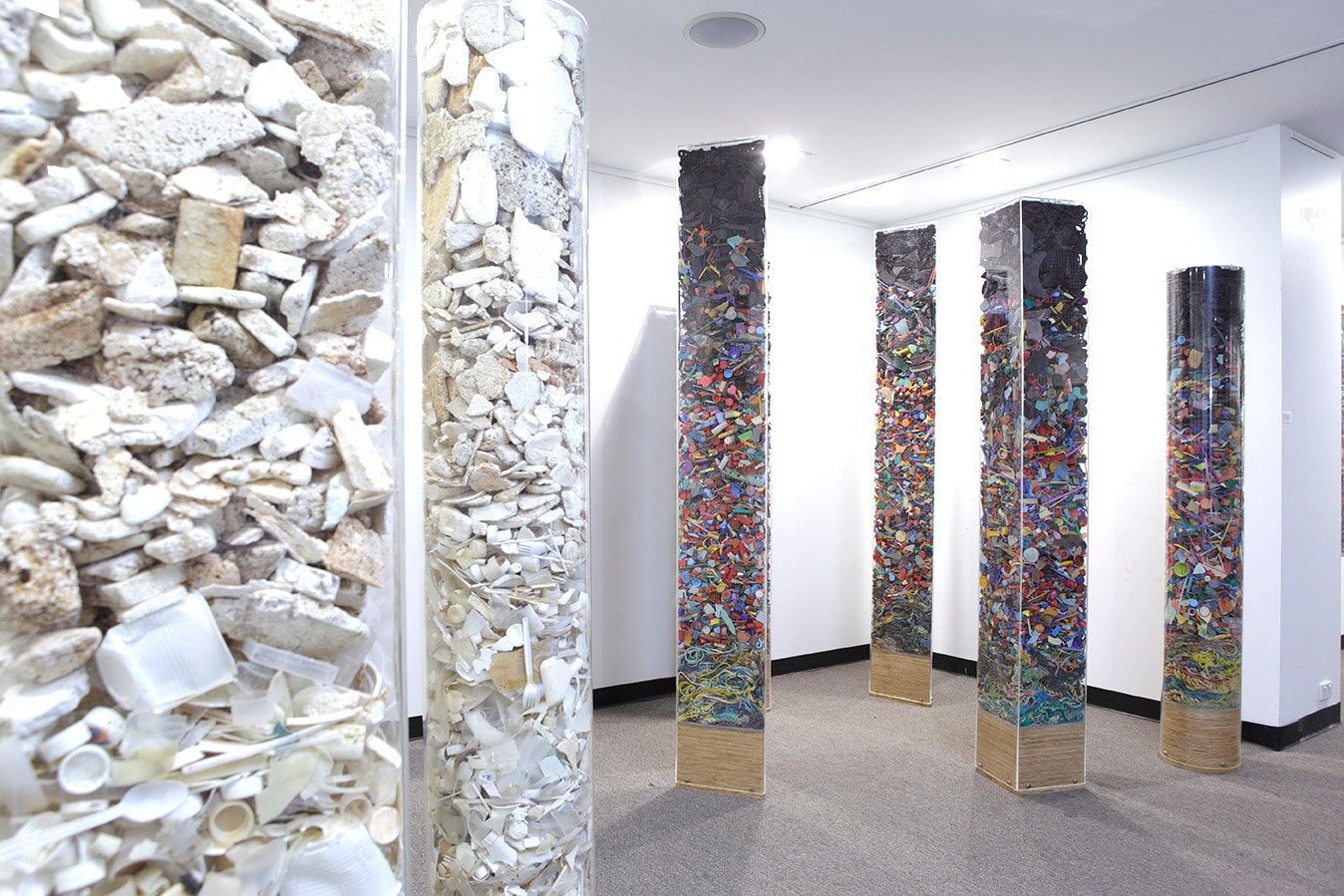
Dahlsen J. (2014) Echoes
Can this art that I show in exhibitions, shift our thinking on matters of sustainability, or is it complicit in the exploitation of the earth’s resources for human consumption?
I see that by making this art, it is a way of sharing my messages for the need to care for our environment with a broad audience. I feel that even if just a fraction of the viewing audience were to experience a shift in their awareness and consciousness about the environment and art, through being exposed to this artwork then it would be worth it. This stems from the fact that I believe presently humanity is at a critical point in time, with our planet currently existing in a fragile ecological state, with global warming hastening unheard of changes, all amplifying the fact that we need all the help we can get.
This is my way of making a difference, and at the same time I’m sharing a positive message about beauty that can be gained from the aesthetic experience of appreciating art, as well as giving examples of how we can recycle and reuse in creative ways.
I believe that we have a long way to go to get big business and the governments of this world to treat the current environmental concerns with the imperatives that they deserve and that are essential. I also believe that the re-education of our species is beginning to happen in a positive way and that change is afoot, however, I also believe it will only reach the levels needed when it becomes economically viable for big business and the governments of this world to take action, but it will get to that point, this I also believe is inevitable.
In the mean time it is up to us individually to bring about change on a personal level by being concious individuals. This will continue to bring about the necessary changes.
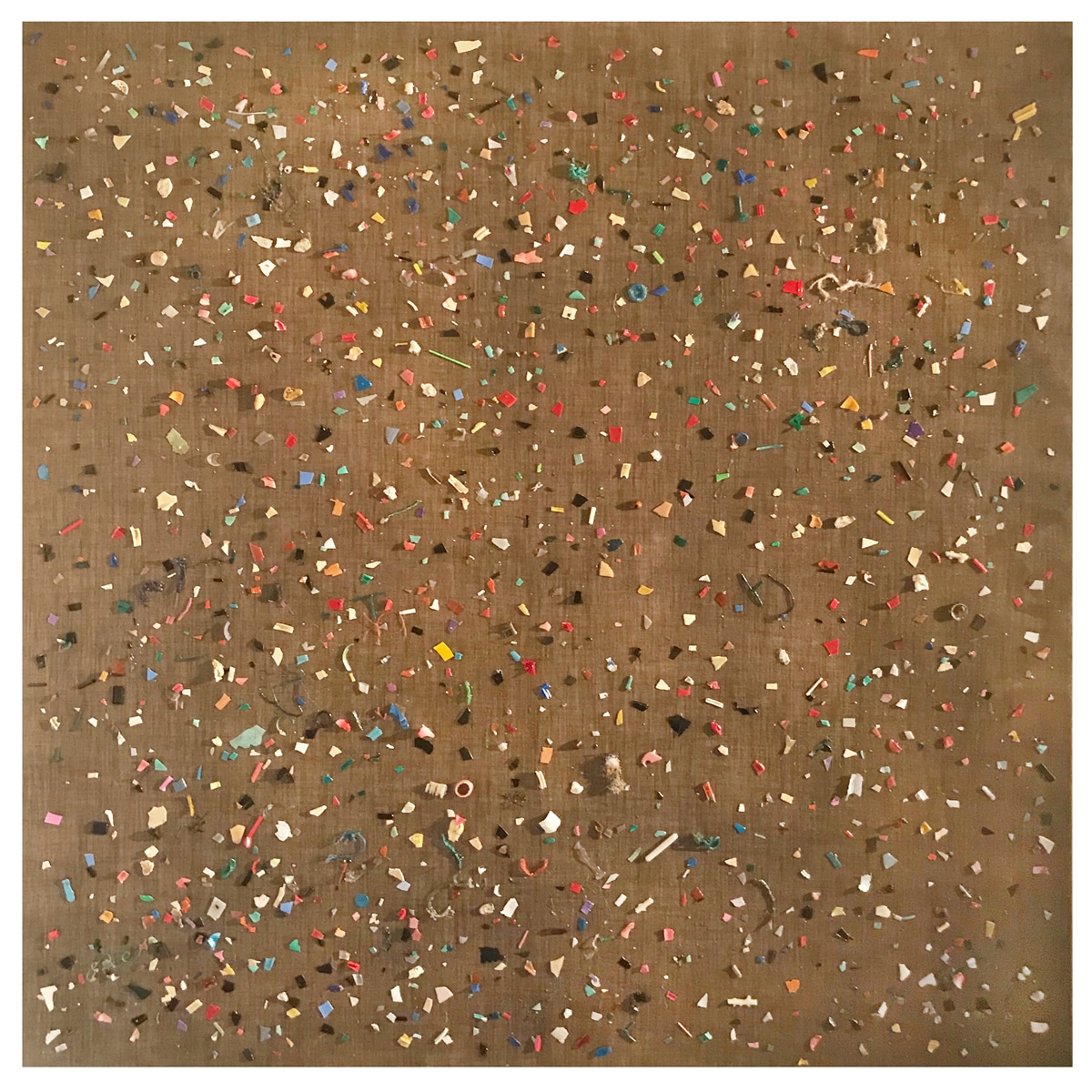
Dahlsen J. (2018) Beach Detail # 8
When I first began working with found objects, I became fascinated by these plastics, and for me it was at first like an epiphany. Suddenly, I felt that I had this enormous meaning that I could express in my art, which included a social conscience, an environmental aspect, and still with a commitment to create objects of beauty. Over the years that followed, I deepened my concern for the environment and researched the extent of the issue as best I could. This helped me to develop a variety of visual art practices including sculpture, installation, assemblage, prints and a return after many years, to painting.
In more recent years it’s really developed into a three-fold concern in my work for me. It comes back to the thesis I did during my PhD, titled Environmental Art: Aesthetics, Activism, and Transformation. Aesthetics is all about beauty. Activism is about the environmental component and making a statement. And transformation is that which becomes possible when people really allow themselves to enter into the work. That’s the something of ‘beyond,’ in a sense a meeting of the two, and that’s something that I hope people get the opportunity to experience with this artwork.
The work and message in it is conditioned by the fact that the raw material I use is ocean litter. As part of my work process includes the raw plastic material, my work as a result, is largely created from these items. As a result, the environmental message is largely conditioned by the fact that the raw material I use is found on Australian beaches. I have seen over the years how marine waste has evolved on beaches and I have lived that process by combining the different disciplines I have available to myself as an artist. I am essentially evolving and creating new modes of expression as I go along.
I can explain my own journey clearly with how I see I have developed a kind of thermometer with which I can measure how marine waste has evolved on beaches. I have lived that process by noticing certain things develop over the years. I’m working on large scale paintings at the moment and when I say painting, I’m basically painting with very small micro pieces of plastic that I’ve been collecting off the beaches.
I would like to know that my message is shared on a broarder scale globally and that people really embrace what it is that essentially I’m wanting to share, which is that they basically engage in being as individually conscious as possible, as no one is going to do that for them. This begins with the most simple of things, like people being kind to themselves, being kind to others and being kind to our beautiful planet. How could people dispose of waste in a careless manner if they are being conscious?
I hope viewers get a sense of both beauty and an increased awareness with everything from the work I’m producing. Making this art is a way of sharing my messages about the need to care for our environment and about the aesthetic experience of appreciating artworks. I believe humanity is at a critical point, with the planet in a fragile ecological state and global warming hastening major changes.
I would like for people to enjoy my work on many levels and can identify with each piece in various ways. I also hope the viewing public can embrace messages in other artists’ work, particularly when they express strong environmental and social statements intelligently and with a high degree of aesthetic complexity.
I see that by making this art, it is a way of sharing my messages for the need to care for our environment with a broad audience. I feel that even if just a fraction of the viewing audience were to experience a shift in their awareness and consciousness about the environment and art, through being exposed to this artwork then it would be worth it. This stems from the fact that I believe presently humanity is at a critical point in time, with our planet currently existing in a fragile ecological state, with global warming hastening unheard of changes, all amplifying the fact that we need all the help we can get.
This is my way of making a difference, and at the same time I’m sharing a positive message about beauty that can be gained from the aesthetic experience of appreciating art, as well as giving examples of how we can recycle and reuse in creative ways.
These artworks exemplify my commitment as an artist to express contemporary social and environmental concerns. By presenting this art to the public, it will hopefully have people thinking about the deeper meaning of the work, in particular the environmental issues we currently face.
I hope these works will act as a constant reminder to people about awareness. I would like them to find enjoyment of the work on many levels and find themselves becoming identified in various ways with each of the artworks they see. I also look forward to the possible discussion that these works may generate. I say these things as being possibilities, bearing in mind as well, that comments are regularly made to me about people’s consciousness, while walking the beach, being awakened after seeing my found plastic object artworks, similarly with seeing my recycled plastic bag series, people have marveled at the creative way I am presenting the recycling theme in an aesthetic way, with this in mind, I have trusted leaving the final alchemy of the work to the viewer, with the possibility they may experience deep perceptual shifts and have a positive aesthetic experience as they interact with my art.
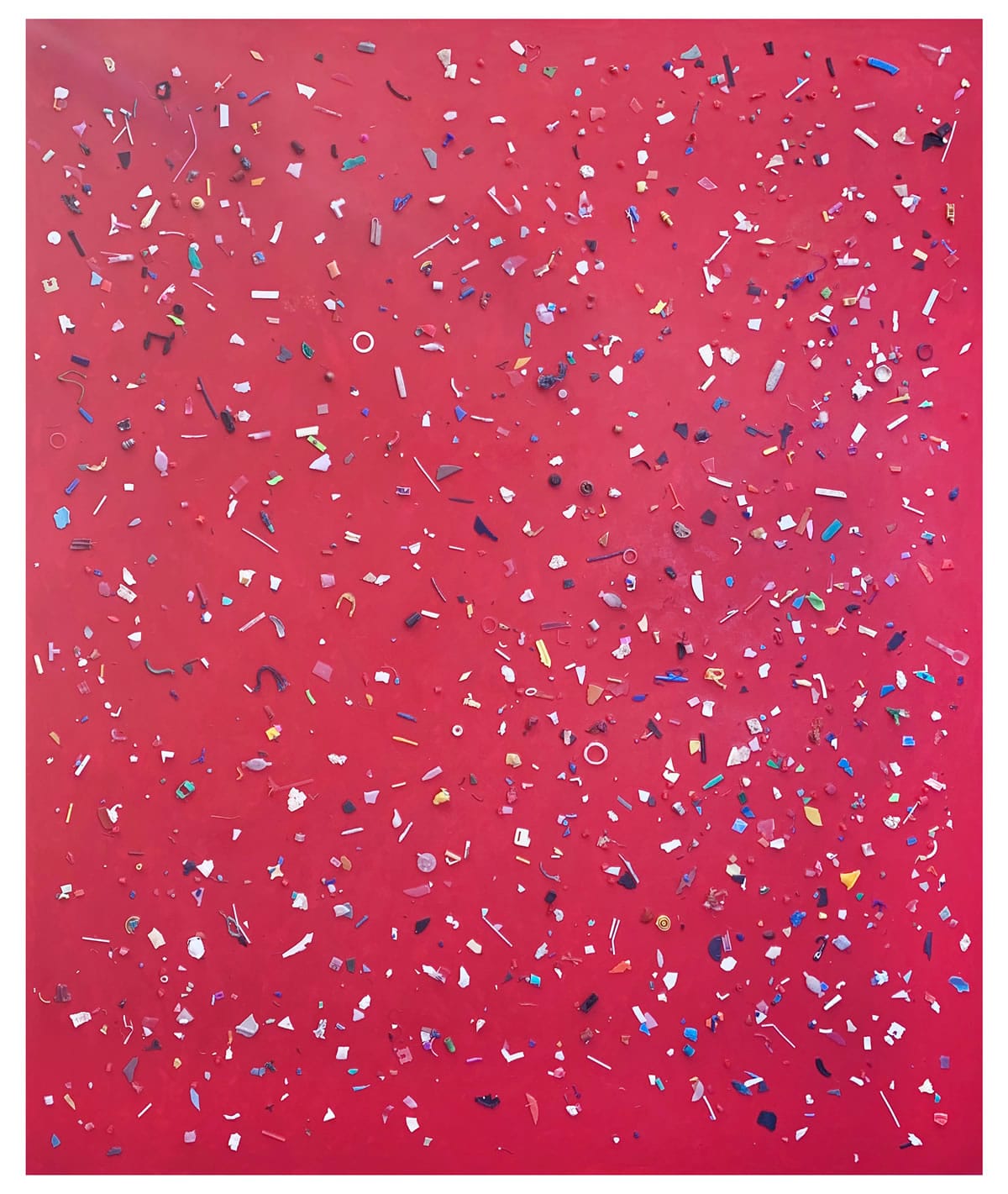
Dahlsen J. (2019) Interior Detail
As an environmental artist, I envision the artist’s role in the fight to protect our earth and our marine life in particular, is multi-dimensional, creating art that makes a difference and has a social conscience through promoting environmental awareness. At the same time, art should share a positive message about beauty that can be gained from the aesthetic experience of appreciating art, as well as giving examples of how we can recycle and reuse in creative ways, while simultaneously highlighting the increasingly perilous state of our oceans. The assemblage artworks I have made over the years are thematically based on environmental issues, taking society’s discarded everyday objects and transforming them into formal compositions.
These recycled materials have been used to convey the history and memory of a place, to comment on the human experience of place, beauty, degradation of the environment and the inspiration possible with recycling through a positive aesthetic experience.
By grouping large areas of similar colours, after an extensive sorting process in my studio, I am able to effectively use three-dimensional objects (usually plastic pieces found on our beaches) and make them have the appearance of two dimensions, as I show them as assemblage works on the wall or as installations. By doing this, the micro always is a major influence, as it essentially creates larger images through this process.
There are elements that are very important to me as an artist, including the meeting of abstraction and figuration. During my twenty years or so as a painter prior to working with found objects, I was very interested in these two aspects meeting and would often describe the work I was involved with then as semi-abstract.
What I have been doing in my work with found plastics has provided the perfect opportunity to create the fusion of these two elements: creating abstract and semi-abstract images through the use of figurative objects, which are the plastics themselves.
The intention of my work is for it to contain both a deep reflection on life, which includes humanity’s current predicament with the environment, while also expressing a positive aesthetic, through the composition and colour of the artworks. By combining a multiplicity of visual and conceptual elements, my work is able to express multiple emotional states at once. This, I believe, negates any necessity for highly figurative signposts within the work in order for it to be successful either individually or as a body of work.
Although these plastics are generally seen as ugly or as trash when seen littering the shores of the worlds beaches, I see something different. I see the potential for art. I am aware there is a universal consciousness of these issues about our beaches being polluted by plastics but at the same time, I’m just hoping that with enough of this type of approach of seeing a potential for beauty in these plastics being transformed into artworks – where people are not being hammered with negativity about the environment – that they become inspired by being exposed to something where there’s a possibility of renewal.
There’s always that possibility of turning something into the positive. Just like collecting rubbish on beaches, you can do something positive, and it can be beautiful as well. If that message gets across by my making the artwork I do, it can only be a good thing. In truth I see something unique in all the plastics that I collect and include in my art, thus on some level I don’t necessarily dislike these plastics.
In my first assemblage works titled “Contemporary Landscapes” made from beach found plastics behind Perspex, created in the past over twenty years ago, dating back to 1998 and 1999, I used recycled materials to convey the history and memory of a place and the degradation of the environment. There is also a close attention to the sense of aesthetics in these works.
As a more evolved artist having worked in the environmental art field for over twenty years now, these elements have deepened and become if anything, more sophisticated, through both my studio based work and my own research as a practicing visual artist over this time.

Dahlsen J. (2005) Thongs
I had a self-held commitment as an artist to express contemporary social and environmental concerns then as I do now. This has grown naturally for me as an artist in my development of working with this found object visual language and is supplemented in parallel, with myself as a person having a natural response to world-wide ever-growing concerns about all aspects of the environment, which now includes the ever pressing need to address global warming and its impact on the environment.
Exhibitions provide a platform for me to create awareness about environmental problems. I am able to use these exhibition opportunities to reveal how I have actively harvested from ‘nature’ the many- times-removed products of human manufacture: the raw material extracted from the earth, processed into commodity, used, discarded, and returned by the tide to human use.
One of my favourite series of works was my series of Totems. I researched the definition of the totem, which was a “symbol of the clan”. I thought how appropriate this was, it is a symbol of our clan with its more recent over the last fifty years or so throwaway mentality, it is also the symbol of the intention of the contemporary human kind to want to make something beautiful out of something ugly. Winning the prestigious Wynne prize at the Art Gallery of NSW in 2000 with the “Thong Totems” was a career highlight, as was being selected as a finalist in 2003 and again in 2004.
The objects yielded by the tide prompted a key question for me: how does one give form to the formlessness of detritus? I was well aware that the organising principles and my choices would determine the meaning of any work created. I began by sorting the found objects into material, natural or manufactured, then into colour and size, his process a self-reflexive examination of categorization. These categories suggested particular works: totem poles constructed from buoys or thongs, wall-based collages of driftwood, and, eventually, coloured plastics assembled into abstract fields that came to evoke semi-abstract landscapes.

Dahlsen J. (2000) Thong Totems Wynne Prize 2000
Unlike most environmental artists, I make my work not from conventionally ‘natural’ materials — soil, grass, stones, for instance — but rather from the ‘artificial’ materials that nature has reclaimed and sculpted through erosion. The work that I make and exhibit, actively mobilises the unstable boundaries between what is human-made and what is natural.
Ultimately, the work reflects on the role of the environmental artist and art practice at the end of the second decade of the 21st century. This is during a time when damage to the environment and economic choices by the government and big business continue to challenge the ideals of environmentalism. The art protests against recklessness on the part of policymakers, while building an aesthetic appreciation of the artwork produced, contributing to new ways of seeing environmental problems.
Dr. John Dahlsen is a contemporary environmental artist and author whose work examines the passage of time in the landscape and the place of humankind within it by working with found objects, primarily ocean trash, to create abstract compositions. He won Australia’s oldest art award, the Wynne Prize, in 2000 at the Art Gallery of NSW and four years later his art represented Australia at the Athens Olympics. He’s also the author of An Artist’s Guide to a Successful Career and An Accidental Environmental Artist. Dahlsen currently lectures in Visual Art at the University of Canberra in partnership with TAFEQLD Southbank Brisbane campus.
